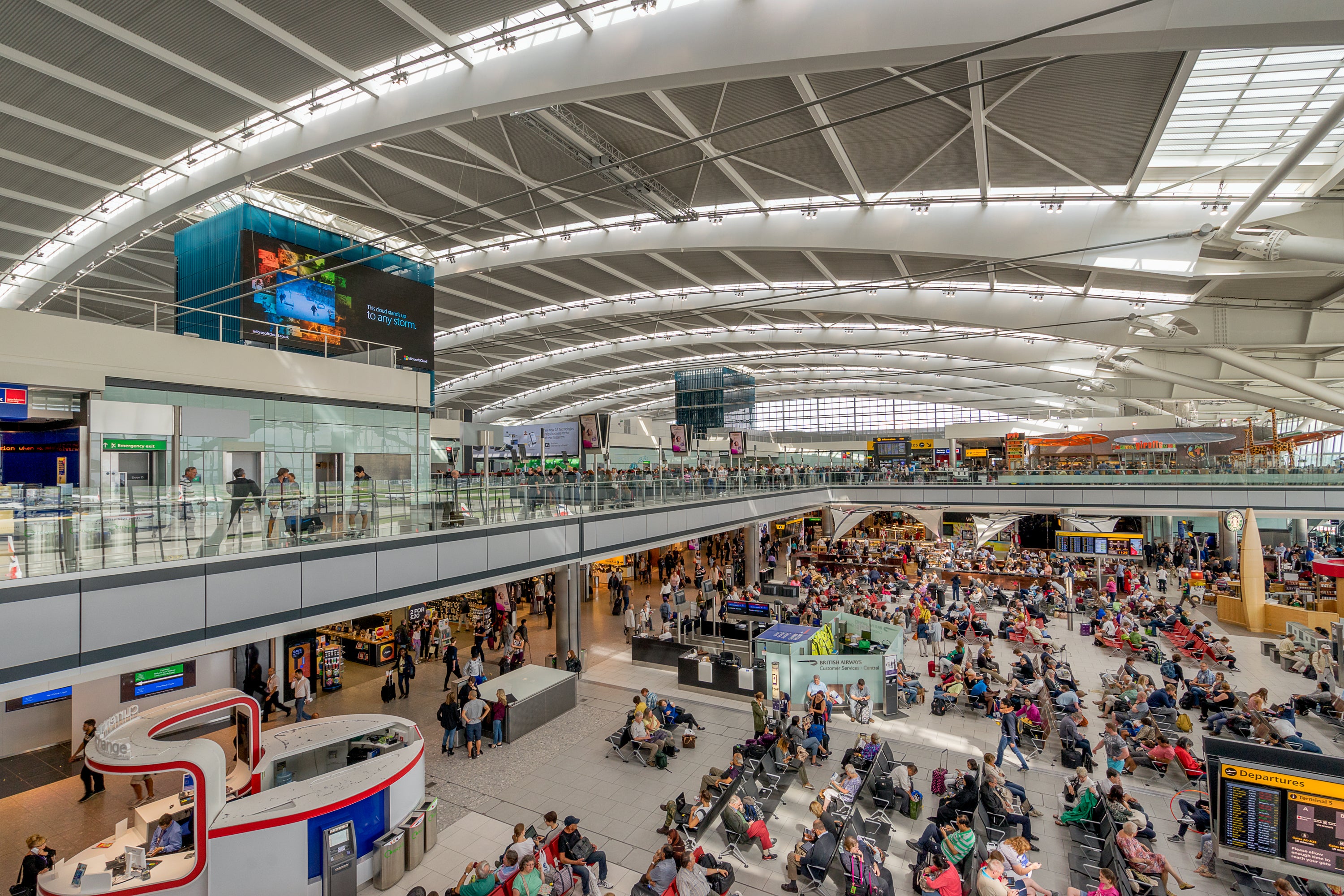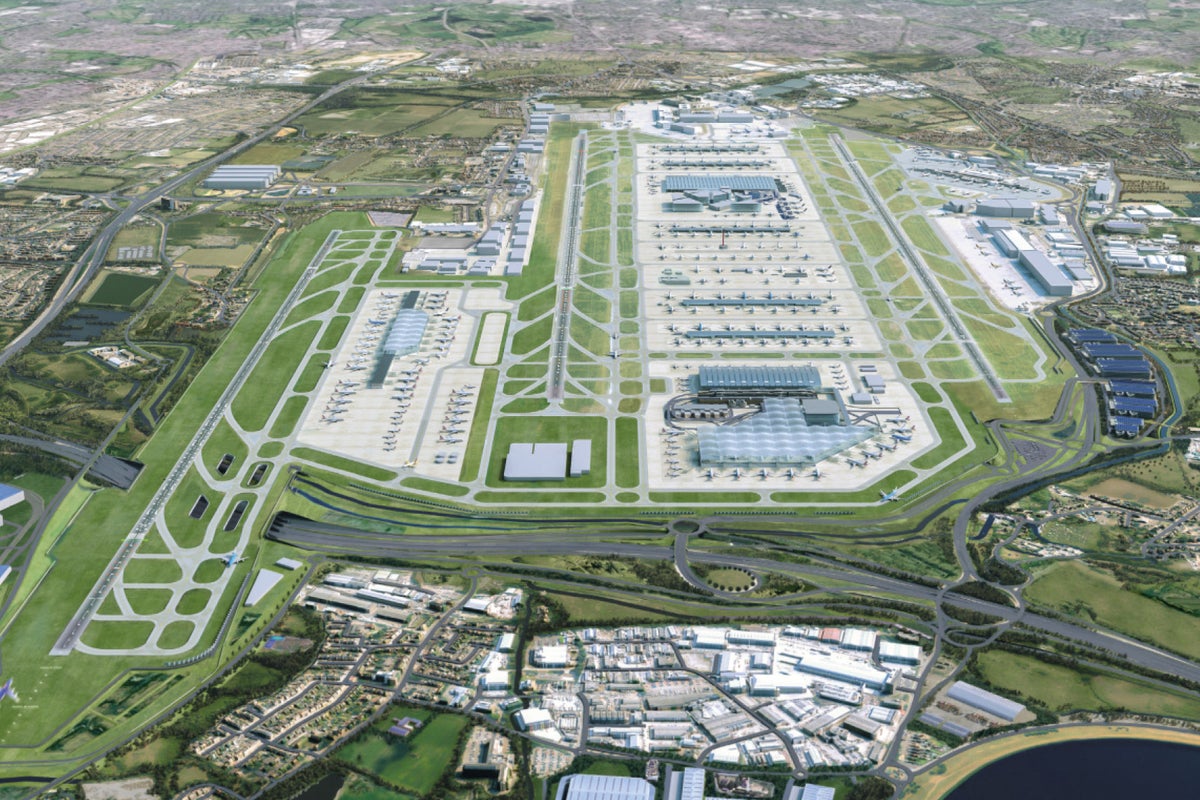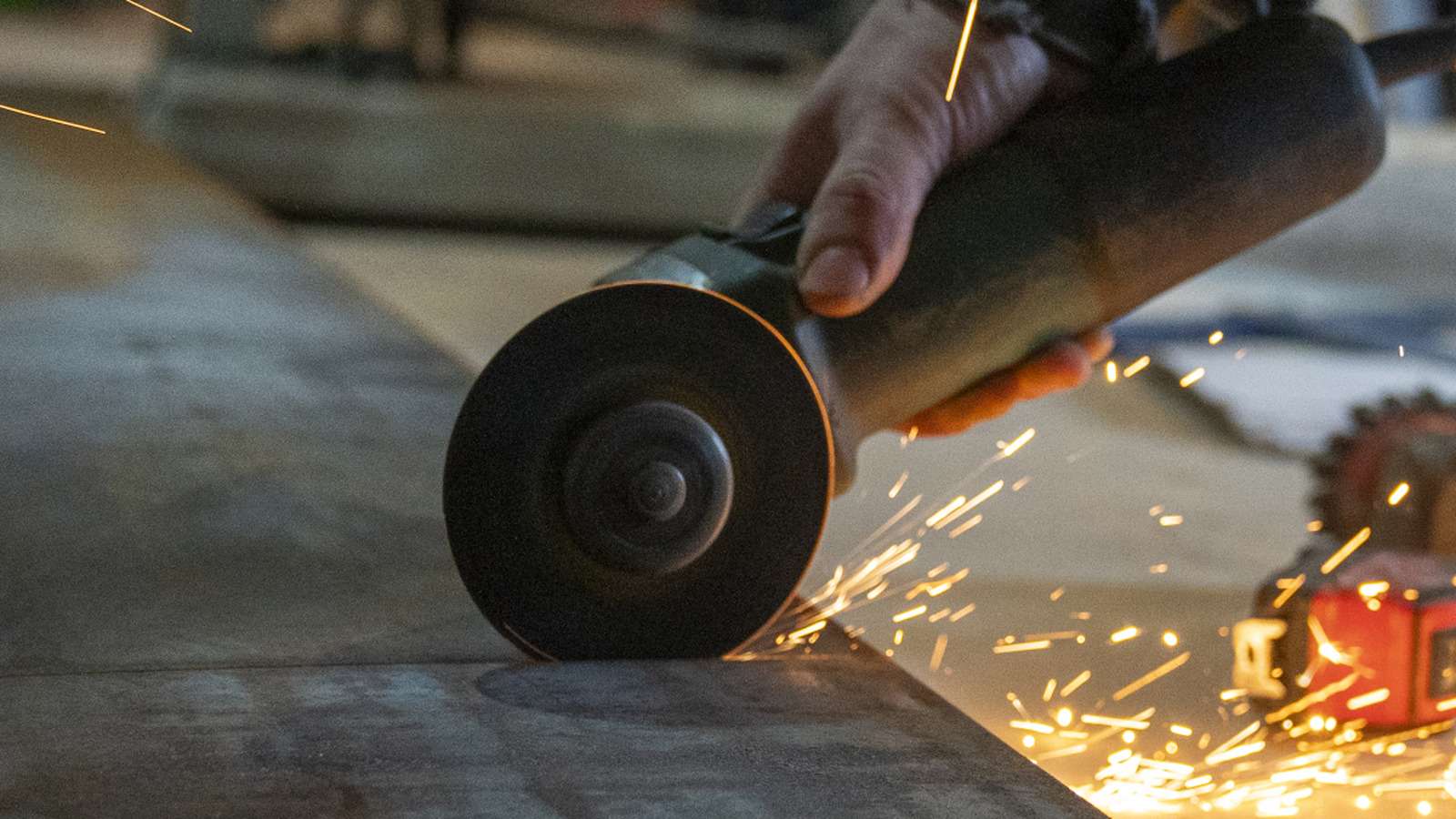- Travel
- News & Advice
A third runway could allow airport to expand to 150 million passengers a year, nearly double the current scale
Simon CalderTravel CorrespondentMonday 24 November 2025 17:21 GMTComments open image in galleryBigger and better? Artist's impression of an expanded Heathrow. The new runway is shown on the left, crossing the M25 motorway (Heathrow Airport Ltd)
open image in galleryBigger and better? Artist's impression of an expanded Heathrow. The new runway is shown on the left, crossing the M25 motorway (Heathrow Airport Ltd)
Sign up to Simon Calder’s free travel email for expert advice and money-saving discounts
Get Simon Calder’s Travel email
Get Simon Calder’s Travel email
 Email*SIGN UP
Email*SIGN UPI would like to be emailed about offers, events and updates from The Independent. Read our Privacy notice
London Heathrow has revealed its latest plans for adding a third runway and building new terminals. Britain’s busiest airport could have extra capacity within a decade, allowing new entrants such as easyJet to set up operations.
But the cost – £21bn for the runway, plus £12bn for new terminal and stand capacity – has alarmed airlines, who fear passengers will be paying in advance for something that won’t benefit them.
The hotelier and property tycoon Surinder Arora has set out competing plans for a cheaper and shorter runway.
Environmentalists argue that any expansion would be a disaster, while history suggests that having a third runway by 2035 is unlikely.
Simon Calder has been covering the airport expansion debate for decades.
What’s the problem with Heathrow’s third runway?
London is the world capital of aviation, with far more people flying in and out than any other city on the planet. It has a total of six airports. In order of size they are Heathrow, Gatwick, Stansted, Luton, London City and Southend. Heathrow is the only one with two runways in permanent use, and is the busiest such airport in the world. All the rest have only one runway; Gatwick, south of London, is the world’s busiest single-runway airport.
Heathrow airport handled 83.9 million passengers in 2024 and is operating very close to its annual limit of 480,000 take-offs and landings. At peak times there is a landing and a take-off every 80 seconds.
Many inbound aircraft fly holding patterns before being cleared to land, increasing journey times, noise, fuel consumption and emissions. As Martin Rolfe, chief executive of the air-traffic control provider Nats, says: “We try to schedule everything, but Heathrow is so constrained that the only way to ensure the runway is in use every second is to have several aircraft effectively circling, ready to come in.”
Outbound departures often have to queue for long spells before take-off.
In bad weather, dozens of flights are cancelled as the air traffic control “flow rate” is reduced.
 open image in galleryHeathrow airport handled 83.9 million passengers in 2024 (Getty Images)
open image in galleryHeathrow airport handled 83.9 million passengers in 2024 (Getty Images)Read more: Airports reveal their calmest periods for flight departures
Heathrow’s chief executive, Thomas Woldbye, says: “It has never been more important or urgent to expand Heathrow. We are effectively operating at capacity to the detriment of trade and connectivity.
“With a green light from government and the correct policy support underpinned by a fit-for-purpose regulatory model, we are ready to mobilise and start investing this year in our supply chain across the country. We are uniquely placed to do this for the country; it is time to clear the way for take-off.”
What is Heathrow proposing?
A “shovel-ready” plan for a “100 per cent privately-financed third runway, capable of flights taking off within a decade”.
As recommended by the 2015 Davies Commission and approved by parliament, the third runway would be “up to 3,500m” long. It would be built northwest of the existing pair and would cross the M25 London Orbital Motorway, which would be placed in a tunnel.
Terminal 5 – used by British Airways – will be expanded, initially by extending the length of one of its satellites, T5C. Another satellite, T5X, will be built to the west behind the existing T5, and will eventually be connected to a new terminal, called 5X North.
Vast amounts of new car parking is proposed to the north and south of the runways.
The extra capacity, airport bosses say, would mean:
- “Cheaper fares through an expanded airline selection
- At least 30 new daily routes
- Extra domestic connections
- A better selection of flight times to the most popular destinations
- Flights quicker to take off.”
 open image in galleryUnder Heathrow’s official proposals, T5 would be expanded (Heathrow Airport Limited)
open image in galleryUnder Heathrow’s official proposals, T5 would be expanded (Heathrow Airport Limited)Watch: One airport rule to watch out for this summer
The easyJet chief executive, Kenton Jarvis, says expansion “represents a unique opportunity for easyJet to operate from the airport at scale for the first time and bring with it lower fares”. Britain's biggest budget airline has never flown from Heathrow because it is unable to get enough slots for an operation at scale.
Ryanair’s chief executive, Michael O'Leary, has predicted the third runway will not be ready until 2040 at the earliest. He says Ryanair is not interested flying from Heathrow.
What will the third runway cost?
In total, the proposals are priced at £48bn.
Heathrow says the runway and associated airfield infrastructure will cost £21bn – 50 per cent more than quoted in 2018, when the price was set at £14bn. Consumer prices have risen only 30 per cent over those seven years, so if the cost was in line it would have risen by £4.2bn. Heathrow says the additional £2.8bn is due to the higher rate of “construction inflation”.
The cost of the new runways and taxiways is only the start. New terminal and stand capacity – principally the new T5X – will cost another £12bn.
“Modernising the current airport through expanding Terminal 2 and ultimately closing Terminal 3” will cost £15bn. This would be likely to happen even without a third runway.
Who will pay?
The airport’s main shareholders comprise a French private equity fund, Ardian, as well as the Qatari and Saudi sovereign wealth funds. They want current passengers to contribute for future expansion. This would be achieved by persuading the Civil Aviation Authority to increase substantially the current price cap per departing passenger of around £25, which is currently charged as part of passengers' fares.
The airlines are furious – particularly British Airways, which would also lose its majority holding of slots at Heathrow. Carriers say the payback should come only when passenger numbers rise.
Willie Walsh, former chief executive of BA and now director general of the International Air Transport Association (Iata), said: “We applaud the government’s decision to support the UK’s global aspirations by advancing plans to expand Heathrow. This must not, however, come at any cost or make any assumption that the current operator is best placed to deliver the value that the UK’s economy will critically need for growth.
“The billions of pounds that have already been invested in Heathrow have under-performed, disappointing both passengers and airlines. So it is doubly important for the billions that will be invested in any expansion to be much better spent. That means focusing on efficiency in all aspects—cost, operations, and customer experience.”
A Virgin Atlantic spokesperson said: “The current regulatory regime is not fit for purpose, guaranteeing the airport inflation-linked returns on their investment, which is ultimately paid for by consumers and airlines through higher charges.”
Sir Richard Branson’s airline uses Heathrow’s oldest terminal, T3, which is 64 years old.
.jpg) open image in galleryThe Arora Group’s proposal avoids the need to build over the M25 (Arora Group)
open image in galleryThe Arora Group’s proposal avoids the need to build over the M25 (Arora Group)Read more: Will passengers ever break the sound barrier again?
What other ideas are out there for airport expansion?
The Arora Group, owned by the property and hotel magnate Surinder Arora, has submitted a proposal for a smaller, cheaper project known as “Heathrow West”. It would avoid the need to build over the M25, “allowing for faster delivery, reduced costs and improved environmental impact”.
Mr Arora says: “The Arora Group has a proven track record of delivering on time and on-budget projects including in and around Heathrow airport. We are delighted that the Government has taken a common sense approach to invite proposals from all interested parties for the very first time rather than granting exclusivity to the current airport operator, no matter its track record.”
Willie Walsh of Iata said: “Having the Arora proposal already brings a welcome new perspective from a company with a respected track record and familiarity with Heathrow.”
Any other options?
Yes. Two veteran aviation figures, Malcolm Ginsberg and former Concorde captain Jock Lowe, have proposed alternatives. Mr Ginsberg has a “London City” plan for a much shorter runway north of the present pair, which he says would be far less disruptive. Captain Lowe wants to have landings and take-offs from an extended northern runway.
Read more: Ridiculous phone roaming bills and how to avoid them
Who is against Heathrow expansion?
Expansion plans face widespread opposition from local residents concerned about extra noise and traffic, as well as environmentalists who say plans to sharply increase the number of flights are completely incompatible with commitments on carbon emissions.
Dr Douglas Parr, policy director for Greenpeace UK, said: “The government has decided yet again to prioritise more leisure opportunities for a comparatively small group of frequent fliers, whilst the rest of us have to live with the consequences of their disproportionate polluting.
“The thousands who live on and around the site of the new runway will see their lives put on hold for a few more years while more money and time is wasted on a doomed scheme to export more tourism wealth out of the UK in the most polluting way possible, until everyone is forced to admit that there will never be enough genuinely ‘sustainable’ aviation fuel to reduce the industry’s emissions, and the economic case for the whole debacle just will not fly.”
 open image in galleryExpansion plans face widespread opposition from local residents and environmentalists (Getty Images)
open image in galleryExpansion plans face widespread opposition from local residents and environmentalists (Getty Images)Paul McGuinness, chair of the No 3rd Runway Coalition, said: “Not only is Heathrow’s third runway proposal set to be by far the most expensive and least cost-effective airport expansion anywhere in the world for each extra passenger, but ratings agents have already said that Heathrow would struggle to raise even half of the £48bn required to fund the project, given the airport’s current debt burden.
“So, even if the taxpayer is called in to foot the bill for the decade of disruptive construction, it seems that Ryanair’s boss wasn't a lone voice when he described the government’s support for Heathrow expansion as ‘HS2 all over again’.”
What happens next?
The Department for Transport will consider the competing options decide, probably by September, on its preferred choice. The Development Consent Order (DCO) process is expected to last around 18 months and will involve yet another public consultation on the expansion plans.
The Planning Inspectorate will consider the application and make a recommendation to the Transport Secretary, who will decide whether to grant the DCO.
If the scheme is approved, opponents of expansion will launch judicial reviews of the minister’s decision. Unless these legal challenges are successful, Heathrow can begin construction of the third runway.
What about the effect on Gatwick and other airports?
Were easyJet to set up at Heathrow, the obvious source of planes, pilots and cabin crew would be its large Gatwick operation. In theory that could reduce choice and increase fares at the Sussex airport. But other airlines might well move in to fill any space created.
But Gatwick has its own cunning plan to bring its standby runway into permanent use. The chief executive, Stewart Wingate, said: “Gatwick's privately financed, £2.2bn plans to bring the existing Northern Runway into routine use has the potential to create 14,000 jobs and generate £1bn a year in economic benefits. The project could be fully operational by around the turn of the decade, if approved with the right conditions to allow quick implementation.”
For more travel news and advice, listen to Simon Calder’s podcast
More about
Heathrow AirportLondon HeathrowAirport ExpansionSimon CalderBritish Airwaysair traffic controlJoin our commenting forum
Join thought-provoking conversations, follow other Independent readers and see their replies
Comments



